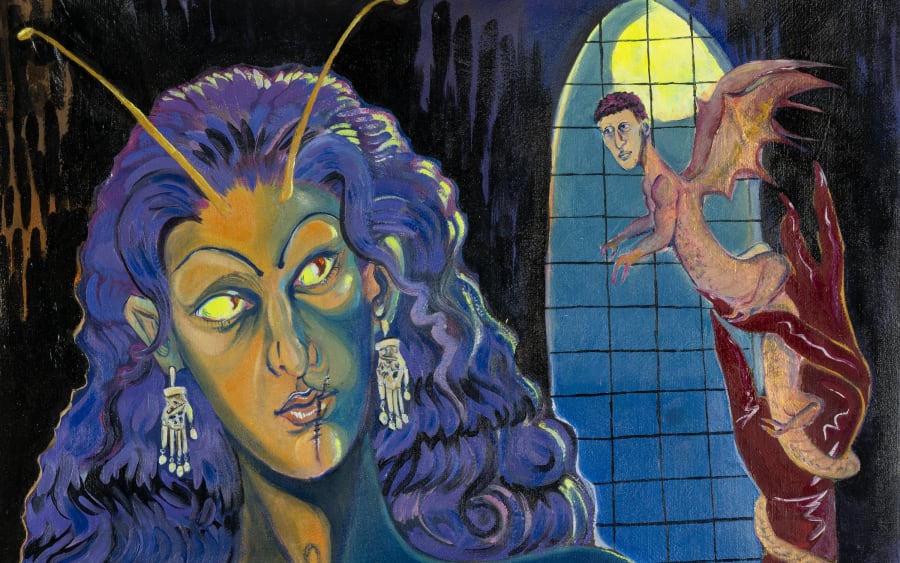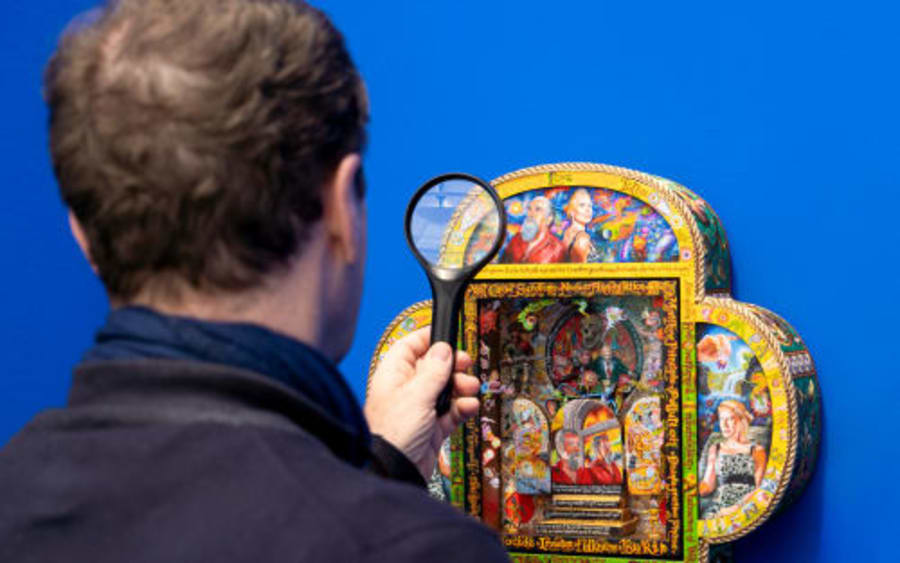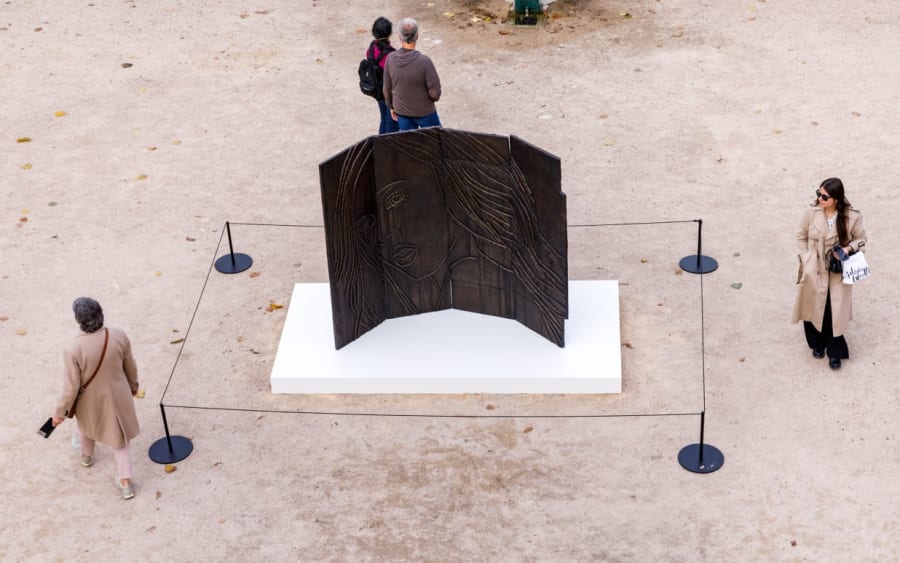Surrealism is having a moment. Last year, the centenary of the movement was celebrated with shows around the world, including the major traveling exhibition ‘Dreamworld: Surrealism at 100’, which opened in Brussels before moving on to Paris, Madrid, Hamburg, and now Philadelphia, where it will run from November 8 to February 16. Such landmark anniversaries often prompt a reassessment, and the appetite for Surrealist work seems to be a hot spot in today’s otherwise subdued market.
The success of the sale of Pauline Karpidas’s London collection at Sotheby’s in September is further evidence of this trend. The works were accumulated during the 1970s and 1980s, with a strong focus on Surrealism, and the white glove auction soared to £101 million, double the low estimate.
Part of the Karpidas appeal, says Thomas Boyd-Bowman, Sotheby’s UK Head of Evening Sales, lay in the collector’s ‘prophetic view of how our generation would now look back at the impact of the influence of Surrealism.’ He adds: ‘There’s an excitement around a much broader group of artists… those artists who exist beyond Surrealism but who seemed to have a natural connection with it, like the Lalanne phenomenon – and that’s what made the Karpidas sale such a great success.’
As Boyd-Bowman suggests, the definition of Surrealism has been expanded by some to encompass everyone from the first-generation artists directly associated with André Breton, the movement’s founder and author of the pivotal 1924 Surrealist Manifesto, right up to contemporary artists inspired by the movement. This expansive definition was applied in a report by Sotheby’s Financial Services on the Surrealist market, published in conjunction with ArtTactic ahead of the Karpidas sale. The study found that, between 2018 and 2024, Surrealism’s market share nearly doubled, rising from 9.3% to 16.8%, helped by numerous artist records set in 2024, such as the $121.2 million achieved for René Magritte’s L’empire des lumières (1954) at Christie’s New York last November – the highest auction price ever for a Surrealist work.
The appetite for the work of women Surrealists such as Leonora Carrington, Remedios Varo, and Dorothea Tanning is experiencing a particularly steep ascent, with the Sotheby’s report finding that auction sales for female Surrealists rose from $7.9 million in 2018 to $94.3 million in 2024 – the latter figure helped by a $28.5 million record for Carrington’s Les Distractions de Dagobert at Sotheby’s New York in May 2024. At Sotheby’s in New York in November, a painting by Frida Kahlo is expected to fetch up to $60 million – a potential record for any female artist.
The 2018–25 period also coincides with the huge demand for Les Lalanne (which performed strongly in the Karpidas sale) and Magritte, artists whose appeal transcends Surrealism as a movement. ‘The success of Magritte is not really to do with his identification as a Surrealist artist in the 1940s but rather the phenomenon of his imagery becoming part of our visual culture and its connection with the world of advertising,’ Boyd-Bowman says. The fact Magritte was so prolific and worked in series – so prices are more easily comparable – also helps his market appeal.
Interestingly, the Sotheby’s report draws three definitions of Surrealists – Classic Surrealists (the core group of Magritte, Salvador Dalí, Max Ernst, etc), Transitory Surrealists (defined as Modern artists who were sometimes aligned with the Surrealists, such as Pablo Picasso, Alberto Giacometti, and Alexander Calder), and Contemporary Surrealists (artists of today influenced by Surrealism, which draws into its remit everyone from Les Lalanne to Glenn Brown and Adrian Ghenie).
However, David Fleiss of Galerie 1900-2000 is wary of diluting the term. The New York and Paris-based gallery was set up in 1981 by his father, Marcel, who was friends with Man Ray and other Surrealists, and represents the estate of Breton. ‘The term needs to be precise,’ Fleiss says. ‘We do show artists influenced by Surrealism, but we can’t call them Surrealists…the focus of the gallery has always been to be close to the real history of the movement.’
At Art Basel in Paris, Fleiss will exhibit works by Francis Picabia, Enrico Donati (including one owned by Breton) and the Canadian artist Mimi Parent, who Fleiss describes as ‘one of the last female surrealists who is not really discovered enough.’ Parent’s work will be priced between €40,000 and €50,000.
Fleiss has noticed a sharp rise in interest in Surrealist works since last year’s centenary exhibitions, as has Olivier Camu, Deputy Chairman and Senior International Director at Christie’s London, who has championed the auction house’s Surrealist sales since 2000. ‘Our latest sale, in March 2025, was our strongest ever – it took off like fuel on fire,’ Camu says. He describes Surrealism as ‘the single most important art movement of the 20th century,’ adding that many contemporary and postwar art collectors today buy Surrealist works. ‘Surrealism is so rich and broad a field because it was not just about plastic art, it was a revolution that applied itself to poetry, politics, literature, cinema – a vast theater of operation and influence.’
The Rome-based gallerist Mattia De Luca has noticed interest peaking over the past three years. ‘There is a sense of curiosity and opportunity, as well as comfort in certain historical artists’ markets,’ he says. ‘This could be younger buyers and burgeoning collectors shifting away from the very speculative contemporary and emerging markets. It is also reflected in the competition for estates and collections of this kind of material by the auction houses.’
Emmanuel Di Donna, the founder of the Di Donna Galleries in New York, has watched demand for Surrealism steadily grow over the past 30 years. He recalls working on the first Surrealist sale at Sotheby’s in London in 2000, when ‘Magrittes that are now four, five, six million dollars were selling for $600,000 to $800,000. The market has broadened. It was limited to Magritte and Dalí back then, but now there is growing interest in female Surrealists and Surrealism in Mexico.’
Di Donna recalls the period of strong Russian buying from the mid-1990s to the mid-2000s, which bumped up prices. Although Russians have withdrawn from the market since 2008, other buyers have stepped in. As Di Donna says: ‘Americans lead the charge but some Asians are very interested in Magritte and Dalí. Japanese [collectors] are very interested in Max Ernst. Europeans and South Americans are also buying. It’s pretty global.’
Until December 13, in collaboration with Ben Brown Fine Arts, Di Donna is hosting an exhibition titled ‘Magritte and Les Lalanne: In the Mind’s Garden’, featuring over 50 works, including paintings, works on paper, and sculptures. Di Donna will also exhibit pieces by Les Lalanne and Dalí, among others, at Art Basel Paris later this month.
Latin American collectors in particular have driven demand for works by female Surrealist artists connected to Mexico, such as Carrington and Varo. The San Francisco-based gallerist Wendi Norris has championed the work of these artists for two decades. She dates the current rise in interest back further than last year’s centenary, to 2012, ‘with great exhibitions at LACMA and [in 2020] the Louisiana Museum, both of which broadened the appeal of traditional Surrealism by focusing on women artists.’ But while artists such as Carrington, Varo, and Tanning are now the subject of multiple museum shows, Norris says there is still ‘more work to do in terms of making them household names like Dalí or Magritte.’
In June, Man Ray’s Noire et Blanche sold for £2.1 million at Sotheby’s in London, the highest price achieved for a photograph so far this year at auction, according to Artnet. This reflects a vogue for Surrealist photography noted by Edwynn Houk, a New York-based specialist in 20th-century photography. ‘No medium represents and illustrates Surrealism as effectively as photography,’ Houk says. In September, the Metropolitan Museum of Art in New York opened a major show of Man Ray’s work to rave reviews. ‘There has been a real focus on Man Ray above all others, even before the mega sale of the Le Violon d’Ingres [for $12.4 million at Christie’s New York in 2022],’ Houk says. ‘At Paris Photo last year, our entire display was focused on Surrealism. We had a terrific response, both from institutions and private collectors.’
Some have attributed the current appetite for Surrealism to similarities between the tumultuous 2020s and the 1920s, a decade recovering from World War One and the Spanish flu pandemic. ‘Surrealism was a product of its time, and the present set of circumstances are oddly similar,’ writes the artist, writer, and curator Robert Zeller in the introduction to the Sotheby’s report, citing the sense of anxiety evoked by the wars in Ukraine and Gaza, as well as the COVID-19 pandemic.
Such parallels may be an oversimplification, but there could be some truth to it. ‘Art is always about escapism or addressing societal problems,’ Di Donna says. ‘Surrealism certainly offers both. It’s a reflection of difficult times, so there’s a darkness, but it also offered an escape route towards dream and beauty. So it’s very relevant today.’
Anna Brady, the former art market editor of The Art Newspaper, is a UK-based writer, editor, and speaker. She was previously the features editor of Harper’s Bazaar Arabia and Harper’s Bazaar Art Arabia in Dubai, and diary editor at The Antiques Trade Gazette. Anna has been a regular guest on Monocle Radio and written for publications including Apollo, House & Garden, The World of Interiors, The Evening Standard, The Independent, The New European and Wallpaper.
Caption for header image: Detail of Man Ray's Chess Set, presented by Francis M. Naumann at Art Basel Miami Beach 2016.
Published on October 14, 2025.


